Double-circuit heating boilers - heat guarantee in the house
Not always the system of centralized heating and hot water work perfectly. More often there are situations when the temperature of the water in the batteries leaves much to be desired, the same problem occurs with hot water. The double-circuit heating boiler will be a real salvation in this situation.
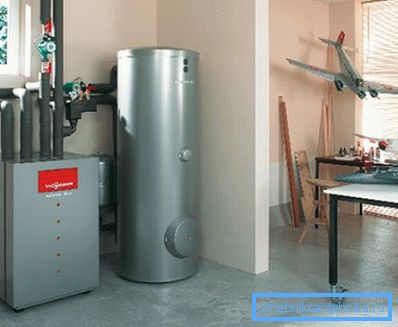
What does the installation of the boiler
The most important achievement is independence from the operation of hot water supply and centralized heating. The main thing is to keep the flow of cold water, and its heating will provide the boiler.
The double-circuit boiler provides such advantages as:
- boilers do not take up so much space, so they can be installed even in small city apartments, where the lack of free space is a common phenomenon. There is no need to allocate a separate room for them;
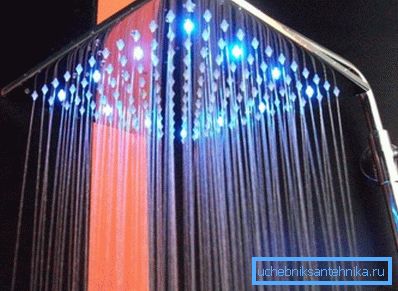
- The vast majority of modern models are provided with devices for adjusting the operation of heating. Due to this, it is possible to achieve an optimal microclimate in the apartment;
Note! In addition to adjusting the operation of heating, there is also a significant saving in the cost of heating.
- safety after installing the boiler at home is not reduced, manufacturers use multi-device protection against overheating, so even if a burner fails, it will simply turn off and nothing terrible will happen.
There are several minor flaws:
- hot water will begin to flow not immediately, but after some time, it is typical for running hot water. The fact is that a double-circuit heating boiler must quickly have time to warm up the cold water passing through the pipe, and this will take some time;
Note! If the need for hot water is great, then it makes sense to stop at the cumulative hot water supply (HWS) scheme. In this case, a boiler is installed in which several dozen liters of hot water are stored.
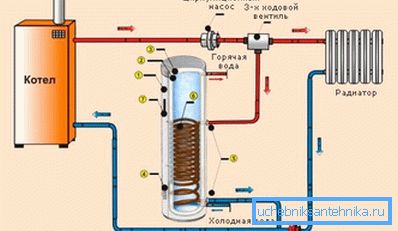
- when using it for hot water supply, hot water is supplied only at one point of dismantling. If the area of the apartment / house is large, it is not very convenient;
- piping a double-circuit heating boiler is more complicated than a single-circuit one.
Classification of double-boiler
Classification of such a device can be performed according to several criteria, for example, by type of ignition, method of installation, type of fuel, etc. Before choosing a particular model, it would be nice, at least in a general form, to familiarize yourself with the types of such devices.
By the method of installation can be identified:
- wall models - often used in city apartments;
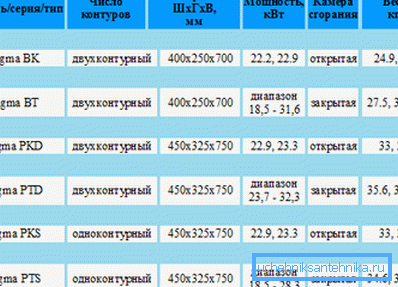
- floor analogues - they are more powerful, but they also occupy places not like an example. Such models are most often used in private homes, and separate rooms are provided for them.
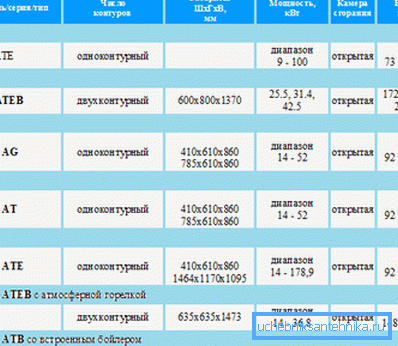
Dual-circuit boilers can be classified by type of work:
- with an open combustion chamber (the second name is atmospheric) - they are distinguished by low cost, but the efficiency is low, the temperature of the gases at the outlet is about 1000? С. Air for burning fuel is taken directly from the room where the boiler is installed;
- turbocharged models - here the chamber is already closed and the combustion of fuel occurs with greater efficiency;
- Condensing boilers - to date, in terms of efficiency, perhaps the best option. At the outlet, the gases have a temperature already of the order of 500? C, that is, the efficiency of the device is higher (according to manufacturers, by about 30% compared with atmospheric analogues). The only disadvantage is the cost, the price of the condensation model can be several times higher than the value of the "aspirated".
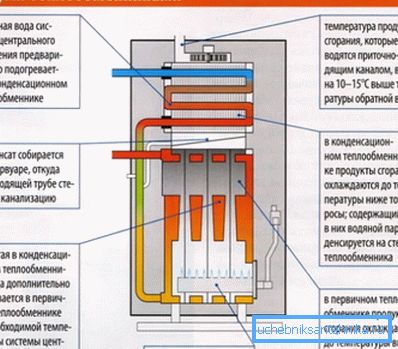
By type of ignition can be identified:
- models with electronic ignition, in this case, the automation will control the operation of the burner based on the temperature of the coolant;
- and devices in which the ignition is performed using a piezo. The main advantage can be considered independence from electricity, such devices are most often used in country houses and in country houses, where there may be power outages.
Separately stand dual-circuit heating boilers. Such devices are intended for use at once 2 types of fuel. Such bundles as firewood-gas, gas - diesel fuel, firewood - diesel fuel, gas - electricity, etc. are used. The main difference from conventional devices is that there are 2 combustion chambers at once (one for gaseous and solid fuel).
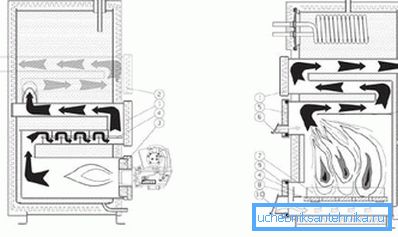
Also, quite often they are additionally equipped with electric heaters, however, in this case, electricity acts as an insurance, and not the main source of heat. When replacing the fuel, it is enough just to change the burner, this is done by hand without calling specialists.
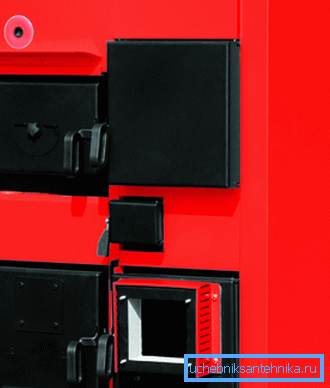
Note! It is possible to connect more than one heating system to such devices, because there are several outputs. So the work of 2 or even more heating circuits can be provided with one dual-fuel boiler.
More about the device and the principle of operation of the double-circuit boiler
In a nutshell, the principle of operation of any boiler can be described quite simply. The fuel is burned, the released energy is used to heat water, which is then supplied either to the pipes of the heating system or to the DHW pipeline. This is a rather simplistic approach, so it makes sense to consider the operation and the device of the boiler in more detail.

Device 2-circuit boiler
A characteristic feature of such a device is the presence of 2 heat exchangers, one of which is used to preheat the coolant, and the second - to meet the needs of the DHW. In the market you can choose from 2 options:
- heating double-circuit boilers with 2 separate heat exchangers (primary and secondary). Primary consists of copper tubes with fins of copper plates - you need maximum heat transfer in a small area, so only copper is used. Secondary - used for hot water supply;
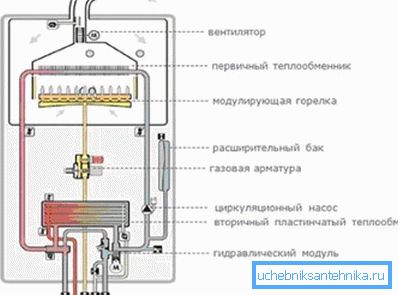
- in some models, the “pipe in pipe” scheme is used, that is, inside a large diameter pipe (water moves along it for heating), a smaller pipe is located, water for DHW flows along it.
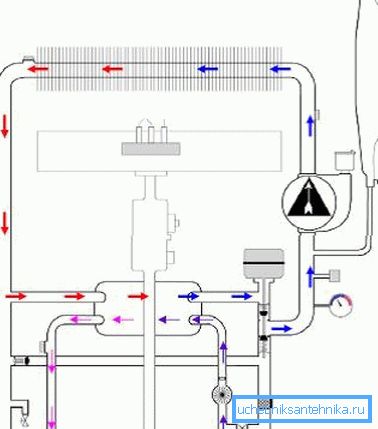
How does a 2-loop boiler
Adjustment of the boiler operation modes is carried out using a three-way valve, which is responsible for where the hot water goes - to the heating system or to the DHW pipeline.
2 operating modes are possible:
- in the heating mode of the house, the primary heat exchanger heats up during the combustion of the fuel, and the valve blocks the flow of water into the hot water pipe;
- in the DHW mode, everything happens exactly the opposite - the heating system’s heating medium temporarily stops heating, and all the hot water goes to the DHW system.
Given this mode of operation of the boiler, it is better to stay on the model with 2 separate heat exchangers. The fact is that it just makes repairs easier. Over time, the composition of the tap water will do its job and the heat exchanger will have to be changed, if there are 2 of them, the replacement will be cheaper.

Is it possible to use several boilers simultaneously
Sometimes this division of operating modes does not suit, in which case the question arises whether it is possible to install a separate boiler for heating and DHW needs.
It can be argued that:
- from a purely technical point of view, this is possible, but connecting two boilers for heating, provided that one of them is used specifically for hot water supply, is illogical. The fact is that in this case, you can forget about adjusting the water in the mixer; in this case, it is more convenient to install a column for heating water;
- You can connect several low-power boilers in a cascade (i.e., in series). In this case, each next will be included in the work after the power of the previous ones is not enough. This will provide the most flexible option for adjusting the heating operation; both conventional and dual-fuel boilers can be used.
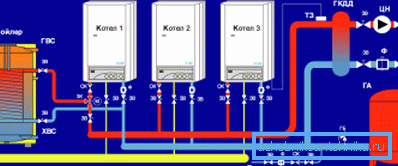
Features of strapping
Under the strapping understand the correct connection of the boiler to the heating system. If you wish, you can list more than a dozen ways. suitable for different situations. The main difference from connecting a single-circuit boiler is that instead of one it is necessary to work with 2 outputs - the heating system is connected to one and the DHW to the other.
Consider a few general recommendations:
- Often there are consumers with significantly different power levels in the heating circuits (for example, conventional radiators are supplemented with a “warm floor” system in some rooms). In this case, a hydraulic separator (also known as anuloid or hydroarrow) is introduced into the heating circuit. This allows for maximum separation of the boiler circuit and the circuit with the inclusion of low-power heaters;
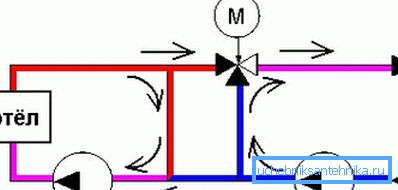
- piping can be significantly simplified if the boiler already has such elements of the heating system as a circulation pump, expansion tank, security system;
- the same boiler can be used for a combined heating system, water can be used in a separate part of it, and antifreeze in another area. The binding instruction in this case requires the installation of a separator. In fact, this device divides the heating system into 2 circuits, the source of energy for them is common, but the other elements (pump, expansion tank, etc.) are common;

- The hot water supply is connected to the second outlet on the boiler.
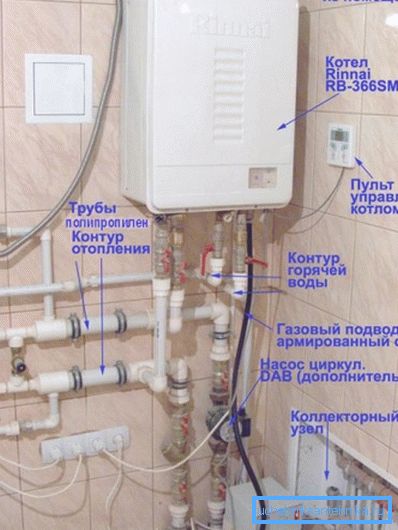
Summarizing
The use of a 2-circuit boiler will reduce the dependence of the house on centralized heating and hot water. Of course, the cost of such a device is significant, but the comfort and savings obtained by adjusting the operation of the heating system are worth it. The proposed material will allow in general terms to get acquainted with the types of boilers, device and principle of operation, as well as the nuances of their connection.
The video shows an example of strapping a double-circuit boiler.